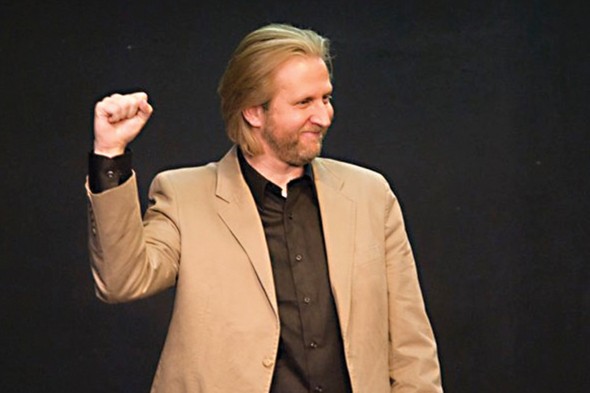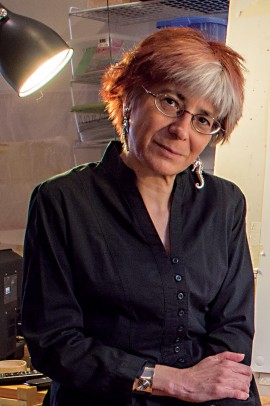Fellowships for artists with disabilities make art accessible

Robert Schleifer is translating Yasmin Reza’s comedy-drama “Art” into American Sign Language for an upcoming production. Photo: Karen I. Hirsch
Two artists are putting American Sign Language on stage and making collaborative “risk pictures” with support from two new fellowships at UIC from 3Arts, a foundation that supports Chicago artists with disabilities.
Portrait artist Riva Lehrer and theater artist Robert Schleifer were invited to accept the inaugural fellowships in the School of Art & Art History.
Each artist receives a stipend and access to UIC resources like studio space, technical assistance and the opportunity for paid lectures or workshops. In the future, the fellowships will be open to all Chicago-area artists with disabilities.
Schleifer began his fellowship in August by translating Yasmin Reza’s comedy-drama “Art” into American Sign Language. The play centers on a man’s purchase of an expensive, all-white painting that his closest friend insists is not art, but a sham.
Schleifer is now casting the production, which may be staged at UIC. It will have three deaf actors on stage using American Sign Language, with voice actors backstage speaking the lines simultaneously.
“I’ve never seen a professional theater production in American Sign Language in Chicago,” Schleifer said.
Two theatre students, junior Joel Collins and senior Gregory Madden, helped with research. “They watched the translation process, learned some American Sign Language and learned about deaf culture,” Schleifer said.
When Lehrer begins her residency in February, she plans to continue a portrait series titled “The Risk Pictures” with portraits of Carrie Sandahl, associate professor of disability and human development, and Lennard Davis, professor of English and disability studies.
Lehrer, who has spina bifida, describes her portraits as “a way to understand what it mean to have an unusual body.” She is concerned with the vulnerability of each subject, balancing the power between artist and subject by taking a risk.
“I give them my art supplies and tell them to do whatever they want in my house. Then I leave the house for a couple of hours,” she said. “They can wander through my house, eat anything from my kitchen. They could set my house on fire. I always wonder why someone will or won’t make a mark on the portrait.”
Lehrer plans to do the same for subjects in her UIC studio. She’ll leave personal items in the studio to increase her vulnerability. “The work can be a stand-in for the body, and it’s a means of facing a certain truth: that control is an illusion,” she said. Lehrer’s studio at UIC will be open for public viewing as she works.
The fellowships are a win-win, says Lisa Yun Lee, director of the School of Art & Art History. “UIC provides resources for the artists to catapult their emerging careers, and the artists help UIC further our mission of creating knowledge that advances social change,” Lee said.

